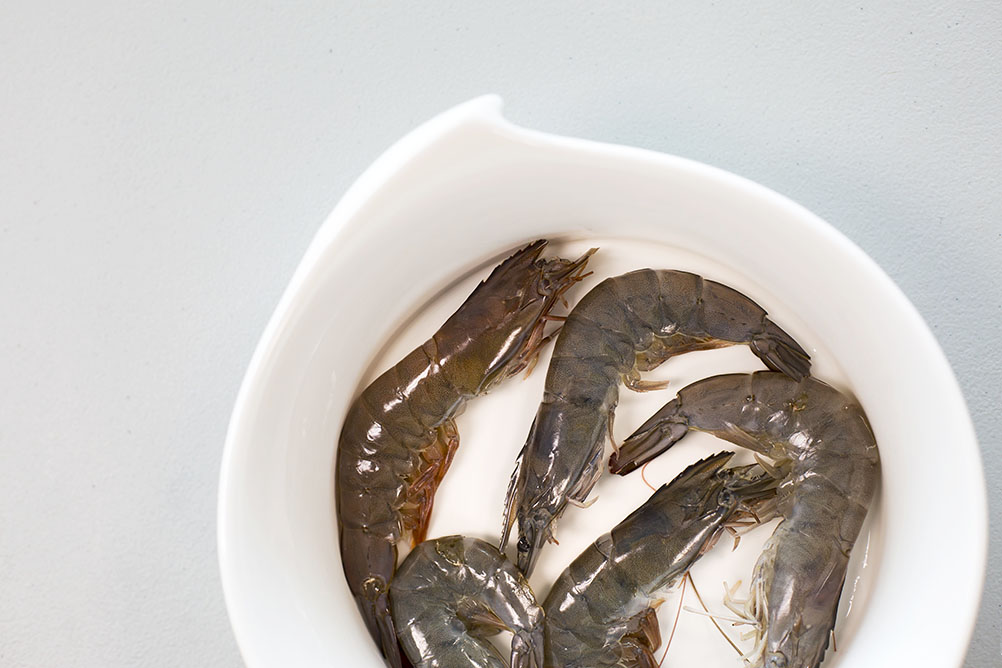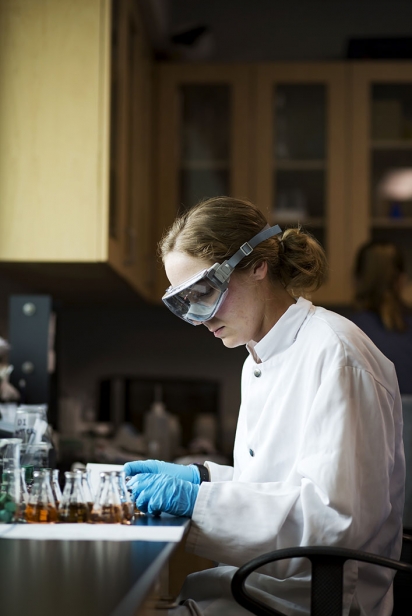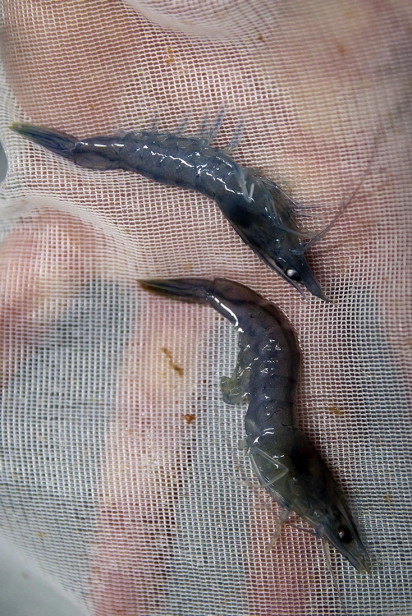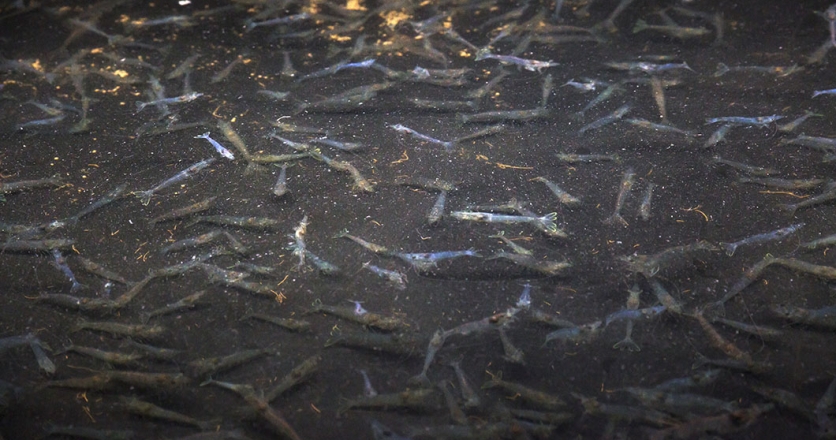Planet-Saving Shrimp?
Sheldon Garfinkle runs what might be the closest thing to a spa for shrimp. As the chief executive of Planet Shrimp, an indoor shrimp farm in Aylmer, Ont., south of London, Garfinkle is dedicated to making life easy for his crustaceans.
Clean, brackish water, scheduled feedings of healthy fish meal, fish oil, probiotics and grains, plenty of room to swim in fresh tanks, a quiet environment and a constant ambient temperature of 30C in bio-secure quarters amounts to shrimp living their best lives before becoming someone’s dinner.
“The whole concept here is to give them a stress-free life for four and a half months,” Garfinkle says. “We simulate their natural environment.”
Even the end of the line for the 137-day-old shrimp sounds peaceful. Garfinkle harvests, freezes, grades and packs them in fewer than six minutes thanks to a slick system of conveyors and flash freezing that Garfinkle describes as a “waterslide” and “Ferris wheel,” which moves shrimp from tank to freezer quickly.
“By virtue of freezing it, we’re locking in nutrients and locking in taste,” he says. “We’re shipping our product frozen as opposed to contending with shelf-life (of fresh shrimp).”
Planet Shrimp sounds like a catchy moniker for a business, but really it translates to a whole new world for producing one of the most consumed seafoods in North America.
The company is on track to harvest 300,000 pounds of shrimp in its 37,500-square-foot aquafarm this year. It’s a small dent in the 1.8 billion pounds that North Americans eat annually. But being housed in a former tobacco warehouse with plenty of room to expand, Planet Shrimp could scale up to 3 million pounds of production and operate its hatchery to forgo importing larvae from Texas, which it currently does
And that’s “without optimization,” Garfinkle notes.
If the company’s analysts pay close attention to the data gleaned in real time at every stage in the life cycle of shrimp passing through here — and they do — production could exceed that and one day make Planet Shrimp the star around which the continent’s shrimp consumption orbits.
A team of scientists keeps track of everything from how much the shrimp eat to the water temperature, salinity and pH in each tank. They note abnormalities, good or bad, and capitalize on that information in future production.
“We’re a technology company as much as a shrimp company,” Garfinkle says. “We’re already seeing improvements and more opportunities for improvements.”
Planet Shrimp farms Pacific white shrimp in a highly automated, proprietary system moving colonies to the next stage of production — and new tanks — every 30 days. All the while, shrimp swim in 10 million gallons of purified, recycled water coursing through the sterile facility every day. Occasionally volumes are topped up because of evaporation, but production doesn’t tax the municipal water system, Garfinkle says.
Planet Shrimp contains effluent, too, rather than discharging it to nearby land or sewers. They filter then dehydrate all byproduct into “cakes” and local farmers use it as fertilizer. Planet Shrimp also eschews hormones, antibiotics or pesticides to produce shrimp. At most, staff members add salt to the water at 13 parts per thousand, less than half the saltiness of the ocean, making Planet Shrimp crustaceans lower in sodium than others on the market.
The result is shrimp with a firmer bite and a fresh, healthy taste.
And more of them, too.
“Our yields are higher than traditional shrimp farms because of the technology we’ve developed,” Garfinkle says. “What’s important from our perspective is clean water yields clean-tasting shrimp, sweet-tasting shrimp.”
At $34.99 a pound, Planet Shrimp isn’t in the business of
producing cheap protein to feed the world, however. Garfinkle uses the word “premium” to describe the shrimp swimming in dozens of shallow tanks stacked six high and stretching the length of a football field at the company’s headquarters.
Chefs at high-end restaurants — including The Winery Restaurant at Peller Estates in Niagara-on-the-Lake and Globe Bistro and Patria in Toronto — are using Planet Shrimp in their kitchens. Caudle’s Catch in Kitchener and Hooked Inc. in Toronto hang their shingles on sustainably sourced seafood and stock Ocean Wise-recommended Planet Shrimp for customers seeking a side of ethics with their purchases.
It’s the cheap shrimp, the $8.99 shrimp ring or bulk scampi sold in grocery stores, that’s an indulgence of scorched Earth proportions. Those tiny crustaceans imported from faraway places come at a considerable cost to the environment and human rights.
Oceana, an international organization focused on ocean advocacy, reports that imported, farmed shrimp can be significantly worse for the climate than beef production. That’s because half of the shrimp farmed in Southeast Asia and Central America is raised in ponds that were once mangrove forests, known to be some of the planet’s most productive and protective ecosystems. Each pound of shrimp farmed on clear-cut mangroves indirectly emits one tonne of carbon dioxide, which is 10 times the carbon footprint of beef raised on clear-cut Amazon rainforest.
Shrimp farming in Thailand, the biggest supplier of imported shrimp to the U.S., has also been linked to human trafficking, child labour and physical abuse.
Wild shrimp aren’t without their issues, either. According to the Monterey Bay Aquarium, shrimp fisheries throw away more catch than they keep. One pound of shrimp caught in the wild results in six to 20 pounds of bycatch. It’s not just other fish getting tangled in shrimp nets, however. Sea turtles, birds and other animals suffer or die to sate our appetites for shrimp cocktail.
Compounding the problem with wild shrimp is the industry’s use of trawling, which scrapes and damages the ocean floor in the process. So, one could see a double meaning when Garfinkle describes his shrimp as clean. Planet Shrimp’s work is necessary, he says, given our collective hunger for the crustaceans.
“It’s well-documented the challenges with imported shrimp. Our shrimp is a solution to those challenges,” Garfinkle says. “As the oceans are proving to have less yield, and the environmental issues [are compounding], demand for shrimp is growing every year. So it’s got to come from somewhere. We’re doing it in a sustainable healthy manner that’s not harmful to the environment. It’s a game-changer. We like to say around here we’re living the future today.”
Planet Shrimp
516 John St., N., Aylmer, Ont.
planetshrimpcompany.com | 519.765.1100 | @planetshrimp










